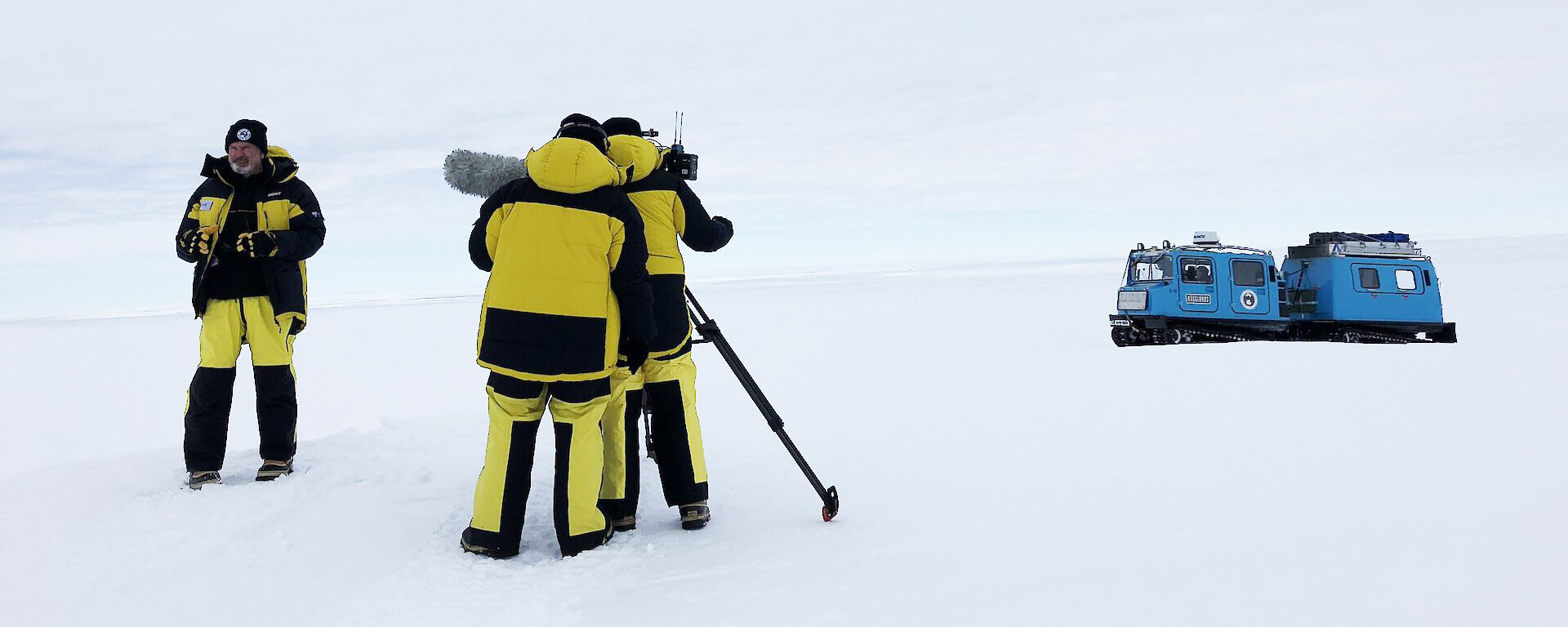Antarctic video gallery
Portside with Nuyina
Video transcript
I’m here in Galati, Romania, to watch the construction of Australia’s newest icebreaker, the research vessel Nuyina.
It’s incredibly exciting to be here and see the ship in such an advanced state of construction, with decks laid, cables pulled, rooms prepared and a team of workers on, working to completion.
This ship is a remarkable addition to our Antarctic capabilities and it will deliver for us opportunities for science research, logistics, passenger transfer and fuel capabilities that we’ve never had before.
When she is launched in Hobart in 2020 she will be the most powerful ship in the Southern Ocean and a terrific contribution to our Antarctic efforts.
[end transcript]
Operation appendix
Video transcript
This is not a situation you want to be in during an Antarctic winter.
Australian Antarctic Division, Chief Medical Officer, Dr Jeff Ayton “The Russian doctor in 1961, Dr Rogozov, having to do his own appendicectomy under local anaesthetic and with assistance from his lay team, which was an extraordinary feat.”
While some people will do almost anything to visit Antarctica. Australian doctors must sacrifice a piece of themselves.
Australian Antarctic Division, Chief Medical Officer, Dr Jeff Ayton “The Australian Antarctic doctors since 1950 have had to have their appendix out. It’s a unique request and it’s always a discussion point at the interview and the medical screening.” It’s a unique request and it’s always a discussion point at the interview and the medical screening.”
The appendix removal policy came into force after a doctor on Heard Island fell ill, requiring a complex emergency evacuation.
With only a single doctor on each Australian Antarctic station over winter, they must be in good health.
Australian Antarctic Division, Chief Medical Officer, Dr Jeff Ayton “It’s not just the instance of appendicitis, it’s the concern about any abdominal mischief and the diagnosis of that remotely when you haven’t got a doctor on site for the doctor. Because appendicitis is a life threatening condition and you can deteriorate within hours to a ruptured appendix and peritonitis and die.” Because appendicitis is a life threatening condition and you can deteriorate within hours to a ruptured appendix and peritonitis and die.”
Despite the unusual job requirement, doctors are still lining up to go south.
[end transcript]
Southern Ocean soundscape
Video transcript
Jacques Cousteau called the underwater world ‘the silent world’ and he couldn’t have been more wrong about that.
There’s a tremendous amount of information that we can learn about the Southern Ocean simply by listening to it.
[Killer whale clicks]
I study underwater sound and particularly the sounds of whales and other marine mammals in the Antarctic.
Blue and fin whales in particular are endangered species. They are very rarely encountered in the Southern Ocean. But when we listen for them, we can hear them over very large distances, so listening for them is an incredibly efficient way to study them.
[Blue whale song]
TEXT BOX: Sonobuoys are deployed from ships to hear and track whales up to 1000km away.
TEXT BOX: Moorings on the sea floor record ocean sounds continuously for one year.
[Whale and seal calls]
TEXT BOX: These yearly sound recordings help scientists learn more about marine mammal behaviour.
A lot of the questions that we're trying to answer; are how many whales are there, where are they, when do we see them? These are really basic fundamental questions that you need to be able to answer if you want to have any chance of conserving and managing populations of whales effectively.
[end transcript]
Antarctic lessons for space
Video transcript
Going to Antarctica is like visiting another planet.
It’s extreme, confined, and isolated.
Chief Medical Officer — Dr Jeff Ayton
“We’ve got isolation for up to nine months of the year, so we can’t get people out of Antarctica. So, we have a small population of 14–25 people at Casey, Davis and Mawson and at sub-Antarctic Macquarie Island.”
Australian Antarctic doctors are experts in remote medical care.
This knowledge informs space agencies planning for long-term missions to the Moon or Mars.
Chief Medical Officer — Dr Jeff Ayton
“Australia has been quite successful in undertaking space analogue research in areas such as immunology, but also mental health and behavioural health. How do teams work well together, but also how to individuals work well together and how can we support them.”
Dr Ayton will share his insights from the icy continent Aerospace Futures 2019.
[end transcript]
Midwinter swim 2019
Video transcript
Amy Chetcuti — Davis Station Expedition Mechanic
Doing the swim was exhilarating. You think you are in there for ages, but it was like three seconds, so survival instincts definitely kick in.
Simon Goninon — Davis Station Leader
Water temperature is around minus 2 degrees, maybe just shy of that. Air temperature today is actually pretty good, around minus 22/23, and not a lot of wind, maybe four or five knots. So it’s actually a pretty good day.
The day on station is just really important for people, whether its people who have been coming down here for multiple seasons, or whether its people, like myself who are down here for the first time. It’s just a really nice way to recognise this turning point for winter, for everyone to gather together, and mark it as a really special occasion.
What it’s actually like to actually take this plunge is a bit hard to describe. Your breath gets taken away, it’s just a completely foreign feeling. You’re in sub zero water, the whole fight or flight response kicks in and you really just want to get the hell out of the water. And to be honest it’s once you’re out that’s the worst thing, because you’re dropping 20 degrees getting out of the water and into the air temp.
Luke D’Anastasi — Davis Station Expedition Mechanic
This is my first time down here and swimming in Antarctica was pretty hectic, pretty cold, I felt like my body was on fire and my head was screaming get to the ladder and get out as quick as you possibly could.
Kieran Lusio — Davis Station Boiler Maker
It’s pretty intense, pretty invigorating. But the water is not too bad, it’s just the getting out bit that’s super cold. I really enjoyed it.
[end transcript]
Southern Ocean — ice and awe
Video transcript
Dr Dirk Welsford (Program Leader, Antarctic Conservation and Management, Australian Antarctic Division)
The Southern Ocean is awesome for lots of different reasons. I mean it’s awesome to look at. Some of the biggest waves in the world come from the Southern Ocean. Waves over 10 metres high. It joins all of the world’s oceans. So, it joins the Pacific, the Indian and the Atlantic Oceans. It’s down there at the bottom of the world.
But it’s full of amazing things as well. That’s where the largest animals in the world live. So, the Antarctic blue whale lives in the Southern Ocean. It’s where a lot of the penguins and seals and things that we think about as being Antarctic, often live near or in the Southern Ocean. The other amazing thing is that one of the world’s most abundant organisms, the Antarctic krill lives in the Southern Ocean and it’s a key part of how that whole system works. It’s food for nearly everything that lives down there. It’s superabundant so there’s lots of things that can grow, happy and fat, eating krill.
And one of the amazing things about the Southern Ocean is that food web is very efficient. It’s quite short. So, you can go from sunlight to microbes, the krill eat the microbes and then you’ve got whales eating those krill. So, very efficient transfer of energy. And you can basically go from sunlight to the world’s largest organism in a very short space.
The whole process of freezing and thawing every year so the sea ice that grows and then melts every year, drives the world’s circulation as well. So, as that ice forms, it sheds the salt out of the saltwater; that salt sinks and that whole process then drives the entire circulation of the world’s oceans.
The Southern Ocean is critical to the world’s climate. So, all of our weather in Australia comes from the Southern Ocean. If you look at the weather map each day, when they do the forecast, you can actually see that these frontal systems are coming across the Southern part of Australia. They all are generated by Antarctica and then are transported across the Southern Ocean to us.
[end transcript]


